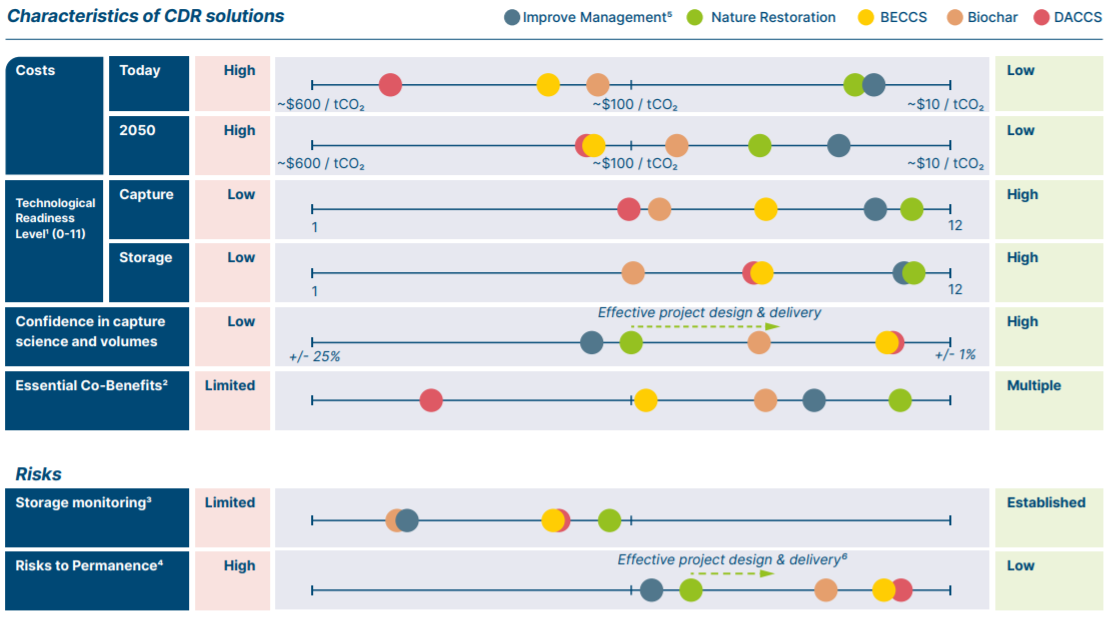deCarbonized #10: Economic co-benefits, 9 actions to scale carbon removals
Nasdaq launches world’s first carbon removal indexes; Occidental signs first “net zero oil” supply deal; Carbon removal start-up Heirloom raises $53 million

⛓ On-chain weekly carbon stats
Toucan Protocol is building carbon market infrastructure to finance the world's best climate solutions. These are our on-chain stats from 17.03- 23.03:

Stats explained...
- Bridged: Toucan’s Carbon Bridge allows anyone to bring carbon credits from legacy registries onto the Toucan Registry
- Traded: This figure represents the combined $ value of all trades in the Base Carbon Tonne (BCT) pool
- Redeemed: Anyone can redeem carbon credits from the BCT or Nature Carbon Tonne (NCT) pool and pay a fee to specify the specific carbon tonne that they would like
- Retired: Redeemed BCT and NCT tokens can be retired and claimed as a carbon offset

📢 Top news
- Occidental signs first “net zero oil” supply deal, using direct air capture technology to remove CO2 emissions
- Nasdaq launches world’s first carbon removal indexes
- nurture.farm is the first company to successfully generate and forward sell agricultural carbon credits
- Carbon removal start-up Heirloom raises $53 million to fund its first pilot-scale facility
- IPCC scientists will examine the potential of carbon removal in a new key report

🌟Co-benefits of carbon credit projects
Economic growth and job creation
A key co-benefit of carbon credit projects is the strengthening and diversification of local economic opportunities.
This contributes to achieving Sustainable Development Goal (SDG) 8, which seeks to "Promote sustained, inclusive and sustainable economic growth, full and productive employment and decent work for all". It proposes to achieve this by:
- Encouraging economic growth to create quality, secure, full-time employment opportunities
- Providing better safety nets for the 61% of the population engaged in the informal economy
- Deploying new technologies and innovative approaches to creating high value industry growth
- Increasing youth employment and training
Achieving these aims accelerates progress towards multiple other SDGs, including reducing levels of poverty and driving the development of new industries and infrastructure.
Impact of carbon projects
Economic growth results from multiple different types of offset project, with some key examples are discussed below.
🌞 Renewable energy projects create opportunities for both skilled and unskilled employment in the construction and maintenance of renewables equipment, like wind turbines.
Projects can also lead to benefits of technology transfer and the development of associated opportunities, such as university research or component manufacture. Finally, if the electricity generated improves a community's energy access then an even broader local opportunities can be created.
Large-scale renewables projects however may also result in negative impacts, such as inequality of job distribution or negatively effecting the ecosystems where the project is constructed.
🌳 Forestry projects can lead to multiple different employment opportunities, including protecting reforested areas, managing agroforestry farms and engaging in opportunities like beekeeping or harvesting fruits or rubber.
These roles can strengthen and diversify a local community’s finances, leading to a stable, growing economy that in turn encourages infrastructure development and education opportunities.
🌱 Ecosystem restoration, similar to forestry projects, can create jobs relating to the protection of certain habitats and those arising form their increased health, such as new or improved fishing opportunities. Ecotourism opportunities may also emerge, creating roles in hospitality or as guides or craft producers.
These emerging opportunities however need to be considered within the restrictions that a restoration project may place on land and resource access, as not to negatively impact economic opportunities.

Measuring and monitoring benefits
As employment is a broad ranging co-benefit that arises from most carbon credit projects, there are no specific standards related to their inclusion.
Indeed, analysis of 80% of the Gold Standard’s portfolio revealed that collectively, projects produced an additional $20 million in employment co-benefits. The most significant project type was reforestation, which produced $27 of co-benefits per tonne of carbon, versus $2 for wind.
It is important to recognise that for employment benefits to provide ongoing value they need to meet certain criteria:
- Jobs need to be stable, long term and of high quality, meaning that offset projects need to be robust over many years.
- Jobs created need to outweigh any loss of jobs from an industry they may displace, for example by creating a protected area that prevents logging activities.
- Opportunities need to be spread as equally as possible across communities to prevent the concentration of wealth, power and access to resources amongst a group of elite individuals.
Successful implementation🦋
Sayalar District Wind Project, Turkey

The Sayalar District in western Turkey has traditionally been an agricultural centre. However, as renewables projects have emerged across Turkey in response to fossil fuel reliance and growing energy demand, the region now hosts several wind power projects.
The Sayalar wind farm aims to create local employment and contribute to local economies through procurement. With support from the Gold Standard, the project now consists of 48 wind turbines that generate over 170,050 mega-watt hours of electricity per year.
The project has provided access to new and better quality jobs, which have been made available to local communities as a priority. Over its lifetime, it is predicted that the project will require 57 construction and 14 operational staff, with training opportunities in additional roles such as security.
The Gold Standard calculate that the value in wages created through these employment opportunities is $200,000 a year, which equates to a $2.30 of co-benefit for each tonne of carbon avoided.
More on the Sayalar District Wind Project Project can be found here.

💼 Jobs board
- Carbon market analyst, London Stock Exchange Group - Pomorskie, Poland
- Business Development Director, Carbon Markets, RippleX - California, US
- Director, Plastics and Sustainable Development Markets, Verra - Global remote
- Project Manager, Climate-Smart Agriculture, Environmental Defense Fund - US remote
- Business Field Coordinator, Carbon Market Mechanisms, Perspectives Climate Group - Hamburg, Germany
🔎 Research in focus
9 actions identified to scale carbon removal technologies

The Energy Transitions Commission, a coalition of leaders from across the energy landscape, have released a report exploring the role of carbon dioxide removals in meeting global climate change targets.
The 'Mind the Gap' report categorizes technologies, explores their potential removal capacity and the current status and risk involved in scaling their deployment.
As depicted below, there are multiple trade-offs between solutions to be considered. For example, direct air capture and carbon storage (DACCS) is one of the most costly, least developed technologies, with low potential to deliver project co-benefits. On the other hand, it possesses the highest level of permanence and has more established safe storage options.

The report concludes with nine recommendations for actions needed throughout the 2020s to ensure that removal technologies are scaled sufficiently. These seek to close the current funding gap, manage risk and create enabling conditions for adoption:
- Scale up voluntary carbon markets via high-ambition corporate action and encourage a shift from avoidance to removal offsets
- Establish high-quality national and regional compliance carbon markets, ensuring they include some removal credits
- Engage direct government support via the funding of removal projects or the purchase of their credits
- Drive indirect government support via adjustments to policies and spending that effect carbon removal solutions, for example encouraging wetland restoration
- Address risks around permanence and additionality, primarily by investing in the development of innovative MRV technologies
- Ensure carbon credits are of the highest possible integrity by improving standards and regulation
- Build associated infrastructure that supports the development of carbon removal supply chains, such as renewable power and carbon capture and storage projects
- Increase education and engagement around the benefits of carbon removal solutions
- Accelerate early stage innovation via an increase in research and development grant funding, from both governments and the private sector
You can read the full report here.

Thank you for reading deCarbonized! 👏
Reach out to us on social and join the community ✨

